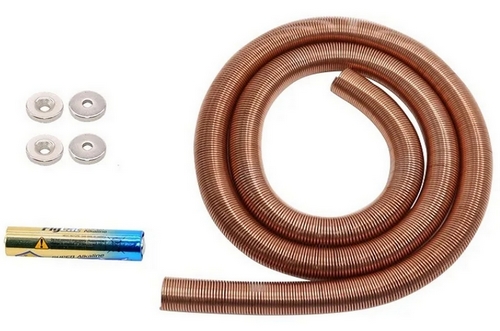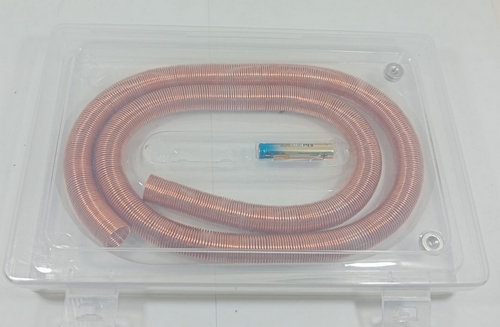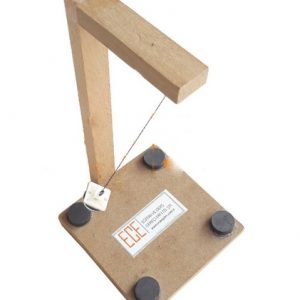Description
- Import of ECE
- Compatible with the curriculum
- Suitable for school, project, experiment, hobby work
- The bare copper wire forming the train track is presented in a plastic housing, ready to use, with magnets and battery
- The wire is 95 cm (± % 5) long without being pulled, 200 cm (± % 5) when extended
- It is shipped in a special cardboard box and a special locked durable plastic storage box
Set Content:
- Train track made of uncoated copper wire: It is wrapped, ready to use. It is approximately 95 cm (± % 5) long in a free state, and 200 cm (± % 5) when extended
- Neodymium magnet: 10 mm in diameter, 2 mm thick, countersunk hole, 4 pieces
Attention: Neodymium magnets are fragile regardless of the brand or origin of the product. Therefore, do not drop magnets, do not hit them against each other, bring them closer together slowly, do not attach them to any metal from a distance. - Battery: AAA pencil battery
- Special plastic storage box: A locked durable plastic box where the product can be placed and stored after use
What is it?
The word Maglev is formed by combining the words magnetic levitation (magnetic and levitation). The Maglev principle forms the basis of the working system of super-fast trains. The Maglev train used today was first patented by James Powell and Gordon Danby in the 1960s. Powell thought that there should be a superior means of transportation than cars and trains, and thought that he could levitate a train using superconducting magnets. The first Maglev train used as a means of transportation was built in England in 1984. The fastest Maglev train carrying passengers today was put into service in Shanghai in 2004. Electromagnets are used in Maglev trains. Thanks to the electromagnetic field created in this way, the train suspended in the air moves on the principle that magnets repel and attract each other. These trains, which are above the rails, do not lose energy because the effect of friction is eliminated, and thus they can reach very high speeds. Studies on these trains, which are used in countries such as Japan, South Korea and China, continue in many countries. The speed record, which was recorded as 603 km/h in Japan in 2015, was broken again in the USA. The train, which was able to travel approximately 826 km/h in the test conducted at Holloman Air Force Base in the State of New Mexico, broke a new record by reaching a speed of approximately 1019 km/h in the test two days later. Although it does not seem possible for such a high-speed train to be used for passenger transportation at the moment, it is predicted that the maglev train, which has significantly increased the speed record, will open the door to new high-speed train technologies.
Working Principle:
- Superconducting magnets hold the train in the air on the rails. These magnets produce magnetic fields much stronger than those produced by ordinary magnets.
- The magnetic field produced is strong enough to hold a train in the air and push it.
- The same poles repel each other.
- These magnetic fields interact with simple metal current loops laid on the rails. The loops are made of conductive material such as aluminum and when the magnetic field passes near them, they create currents that will create another magnetic field.
Advantages:
- It is faster.
- It is less costly.
- Since there is no friction, the parts wear out in a longer time and have a longer life.
- It is safe. Since the speed at which the trains travel on the road and the distances between them are determined automatically, there is no risk of collision. The risk of derailment is almost impossible.
- Since it is sturdy and balanced, it can be designed to be wider and more comfortable than normal trains.
- It adapts more easily to high landforms compared to traditional trains. Thus, there is no need to make arrangements such as shaving hills in landforms.
- It is energy efficient. It uses electricity from coal, nuclear, water, fusion, wind or solar sources, not oil like other means of transportation.
- It is environmentally friendly.
- It is silent since there is no friction.
Targeted Gains:
- Explains the reasons for the magnetic properties of magnets and classifies substances according to their magnetic properties.
- Explains the repulsion and attraction forces between magnets using the concept of magnetic field and analyzes the variables on which this force depends.
- Analyzes the variables that affect the magnetic field created by a straight conductor with current passing through it.
- Expresses that some substances are affected by magnets.
- Explains that the force applied by magnets to substances is a force that does not require contact.
- Lists the areas of use of magnets in daily life.
- Knows that electromagnets are examples of areas of use.
- Knows that the friction force can be reduced by the repulsion of the same poles of the magnet and the speed of the maglev train can be increased.
- Can give examples of areas of use of the maglev train.















Reviews
There are no reviews yet.